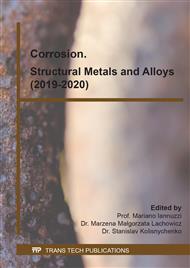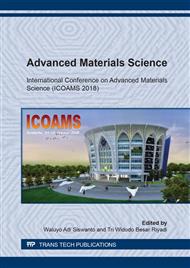[1]
S.J. Kim, S.K. Jang, M.S. Han, J.C. Park, J.Y. Jeong, S.O. Chong, Mechanical and electrochemical characteristics in sea water of 5052-O aluminum alloy for ship, Trans. Nonferrous Met. Soc. China 23 (2013) 636−641.
DOI: 10.1016/s1003-6326(13)62510-8
Google Scholar
[2]
J.C. Park, S.J. Kim, Mechanical characteristics of cast ac7av alloy after alternative multi-pass friction stir processing, Surface Review and Letters 17 (1) (2010) 69–72.
DOI: 10.1142/s0218625x10013837
Google Scholar
[3]
A.S. Darmawan, A.D. Anggono, A. Hamid, Die Design Optimization on Sheet Metal Forming with Considering The Phenomenon of Springback to Improve Product Quality, MATEC Web of Conferences 154 (2018) 01105.
DOI: 10.1051/matecconf/201815401105
Google Scholar
[4]
B. Wang, X.H. Chen, F.S. Pan, J.J. Mao, Y. Fang, Effects of cold rolling and heat treatment on microstructure and mechanical properties of AA 5052 aluminum alloy, Trans. Nonferrous Met. Soc. China 25 (2015) 2481−2489.
DOI: 10.1016/s1003-6326(15)63866-3
Google Scholar
[5]
C. Meng, D. Zhang, H. Cui, L. Zhuang, J. Zhang, Mechanical properties, intergranular corrosion behavior and microstructure of Zn modified Al-Mg alloys, Journal of Alloys and Compounds 617 (2014) 925-932.
DOI: 10.1016/j.jallcom.2014.08.099
Google Scholar
[6]
A S. Darmawan, T.W.B. Riyadi, A. Hamid, B.W. Febriantoko and B.S. Putra, Corrosion Resistance Improvement of Aluminum under Anodizing Process, AIP Conference Proceedings 1977 (2018) 020006.
DOI: 10.1063/1.5042862
Google Scholar
[7]
J. Koike, M. Mabuchi, K. Higashi, In situ observation of partial melting in superplastic aluminum alloy composites at high temperatures, Acta Metallurgica et Materialia 43 (1) (1995) 199-206.
DOI: 10.1016/0956-7151(95)90275-9
Google Scholar
[8]
M. Jobba, R.K. Mishra, M. Niewczas, Flow stress and work-hardening behaviour of Al–Mg binary alloys, International Journal of Plasticity 65 (2015) 43-60.
DOI: 10.1016/j.ijplas.2014.08.006
Google Scholar
[9]
M.P. Liu, T.H. Jiang, J. Wang, Q. Liu, H.J. Roven, Aging behavior and mechanical properties of 6013 aluminum alloy processed by severe plastic deformation, Transactions of Nonferrous Metals Society of China 24 (12) (2014) 3858-3865.
DOI: 10.1016/s1003-6326(14)63543-3
Google Scholar
[10]
X. Liu, X. Zhao, Y. An, G. Hou, S. Li, W. Deng, H. Zhou, J. Chen, Effects of loads on corrosion-wear synergism of NiCoCrAlYTa coating in artificial seawater, Tribology International 118 (2018) 421–431.
DOI: 10.1016/j.triboint.2017.10.019
Google Scholar
[11]
L. Shan, Y. Wang, Y. Zhang, Q. Zhang, Q. Xue, Tribocorrosion behaviors of PVD CrN coated stainless steel in seawater, Wear 362-363 (2016) 97–104.
DOI: 10.1016/j.wear.2016.05.016
Google Scholar
[12]
Y. Zhang, X.Y. Yin, F.Y. Yan, Tribocorrosion behaviour of type S31254 steel in seawater: Identification of corrosion–wear components and effect of potential, Materials Chemistry and Physics 179 (2016) 273-281.
DOI: 10.1016/j.matchemphys.2016.05.039
Google Scholar
[13]
L. Shan, Y. Zhang, Y. Wang, J. Li, X. Jiang, J. Chen, Corrosion and wear behaviors of PVD CrN and CrSiN coatings in seawater, Trans. Nonferrous Met. Soc. China 26 (2016) 175−184.
DOI: 10.1016/s1003-6326(16)64104-3
Google Scholar
[14]
F. Guan, X. Zhai, J. Duan, J. Zhang, K. Li, B. Hou, Influence of sulfate-reducing bacteria on the corrosion behavior of 5052 aluminum alloy, Surface & Coatings Technology 316 (2017) 171–179.
DOI: 10.1016/j.surfcoat.2017.02.057
Google Scholar
[15]
E. Canepa, R. Stifanese, L. Merotto, P. Traverso, Corrosion behaviour of aluminium alloys in deep-sea environment: A review and the KM3NeT test results, Marine Structures 59 (2018) 271–284.
DOI: 10.1016/j.marstruc.2018.02.006
Google Scholar
[16]
T. Zhao, Z. Liu, C. Du, M. Sun, X. Li, Corrosion fatigue crack initiation and initial propagation mechanism of E690 steel in simulated seawater, Materials Science and Engineering: A 708 (2017) 181-192.
DOI: 10.1016/j.msea.2017.09.078
Google Scholar
[17]
H.N. Krogstad, R. Johnsen, Corrosion Properties of Nickel-Aluminium Bronze in Natural Seawater − Effect of Galvanic Coupling to UNS S31603, Corrosion Science 121 (2017) 43-56.
DOI: 10.1016/j.corsci.2017.03.016
Google Scholar
[18]
H. Li, H. Yu, T. Zhou, B. Yin, S. Yin, Y. Zhang, Effect of tin on the corrosion behavior of sea-water corrosion-resisting steel, Materials and Design 84 (2015) 1–9.
DOI: 10.1016/j.matdes.2015.06.121
Google Scholar
[19]
T. Zhao, Z. Liu, C. Du, C. Dai, X. Li, Corrosion fatigue crack initiation and initial propagation mechanism of E690 steel in simulated seawater. Materials Science and Engineering: A 708 (2017) 181-192.
DOI: 10.1016/j.msea.2017.09.078
Google Scholar



